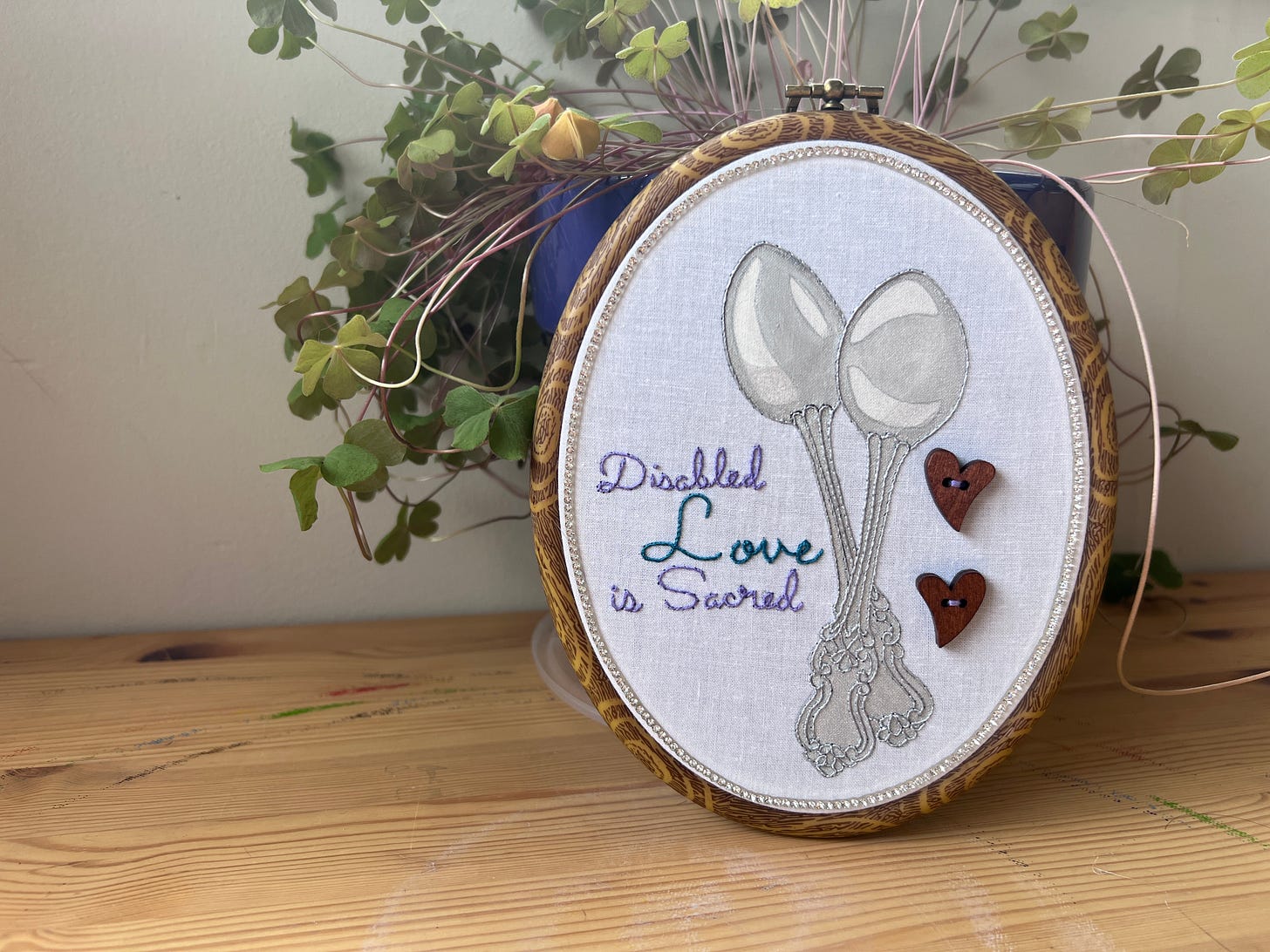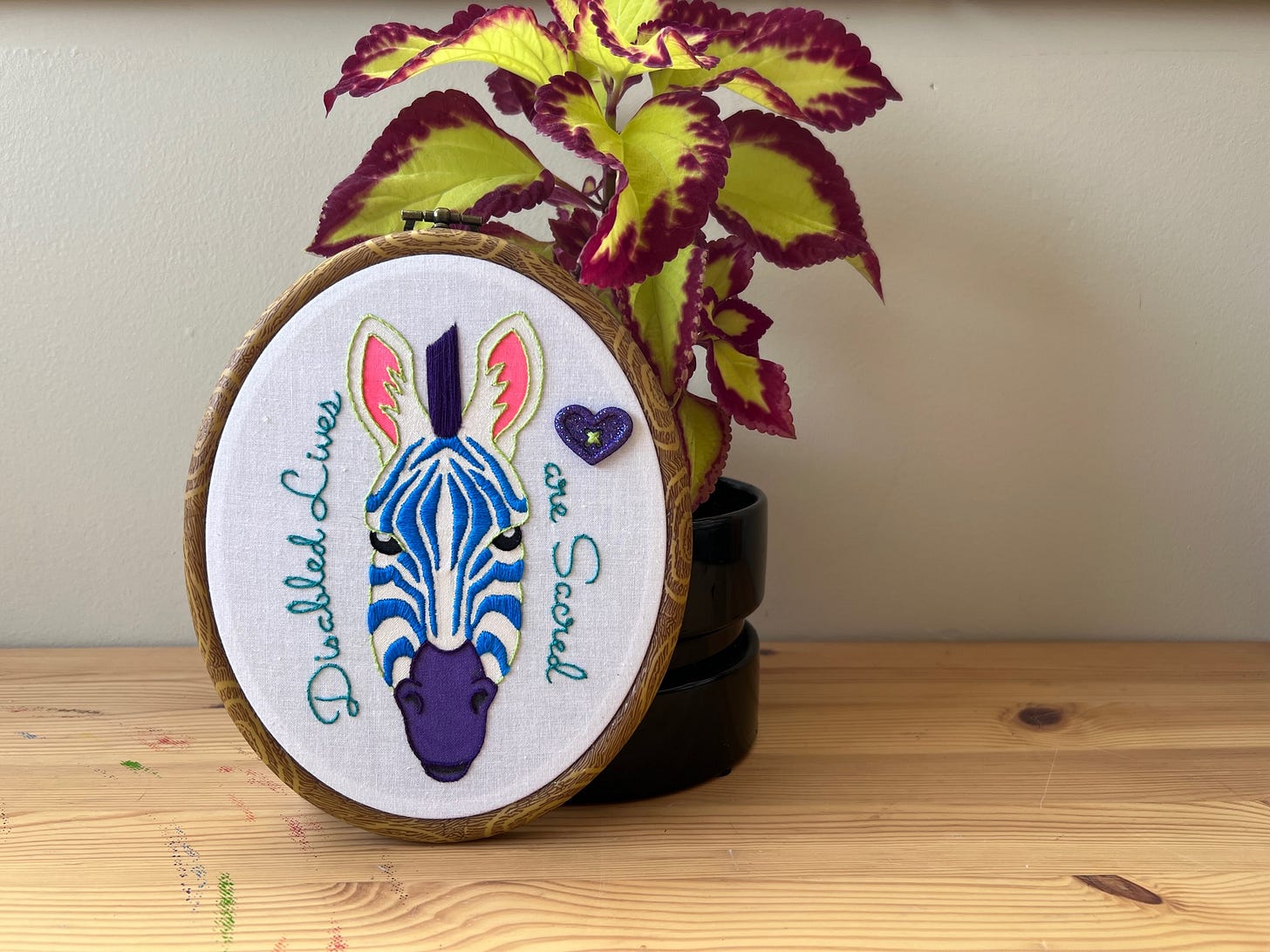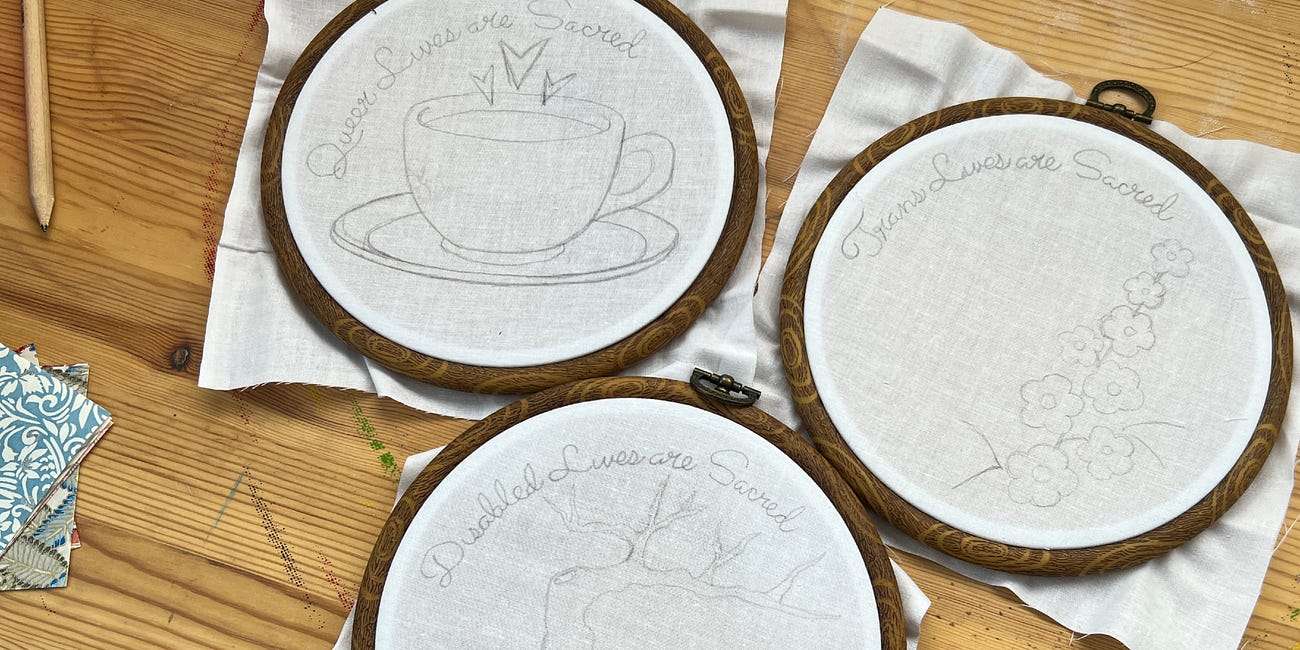Reading time: About 5 minutes

Sacred Love/Sacred Lives is a mixed-media embroidery art project I began at the end of 2022. I shared an initial round of artist statements in November 2023. Since then I have continued to work on statements for completed pieces in the series as and when energy allows. I’m not putting a deadline on these statements, nor am I completing them in the order that I complete the pieces. It’s more like, when the mood strikes, I sit down and write one. And when it feels complete, I’ll publish it.
So, without further ado, some more artist statements from completed pieces in the Sacred Love/Sacred Lives mixed media embroidery project.
Don’t let anyone tell you your life and who you love and how you love is anything less than sacred.
Disabled Love is Sacred, Spoonie Love
Mixed-media: Acrylic paint, stick on rhinestones, wooden beads and embroidery floss
Spoon theory originated with a blog post by Christine Miserandino as a way to explain what it’s like to live with a chronic illness. The first time I heard the term ‘Spoonie’ and what it meant, it resonated with me. I have since credited the term with helping me to “come out” as a disabled person, much like first hearing the term “bisexual” helped me on the path of naming my queer identity.
When designing this piece, I wanted to show the support and love found in disability solidarity and how we take care of each other as disabled folks. We provide one another with guidance on how to navigate the medical system. We share the names of health practitioners well versed in the conditions we live with and who to avoid. We teach one another how to advocate for ourselves. We share resources as a way to reduce the cost of the disability tax. We pass on tips and tricks for caring for our unpredictable bodies or the unpredictable bodies of our loved ones. We give one another space to vent, and offer validation for the frustrations we feel at having to fight so hard to be believed and access treatment, mobility devices, and be included in public spaces. We don’t default to trying to “fix” each other; we support and affirm one another.
Disabled folks are also as likely to be a caregiver as we are to need care. We understand that this is not a “special” thing about being disabled, but a deep insight into the human condition. We need each other, all of us, and when we acknowledge that and live in accordance with it, our lives are richer for it.
Disabled Lives are Sacred, Zebra
Mixed-media: Fabric marker, acrylic paint, button and embroidery floss
Many symbols associated with disability have contentious origins and are affiliated with organizations who took or take a paternalistic, infantilizing view of disabled people. To find symbolism that comes directly from the disabled community, one must dig a little deeper. The zebra is an interest symbol in this regard, because it crosses both abled and disabled perspectives. Some abled people have used the zebra to represent how disabled people see themselves as “special”, a term with a lot of baggage. But I see the zebra in a positive light, as I first encountered it through Disability Justice and how it is used by disabled folks to represent the dynamic and multi-faceted experiences of disability.
The zebra is most strongly associated with Ehlers-Danlos syndrome, or EDS, the connective tissue disorder I was born with. I have hypermobility type, or hEDS, one of 13 varieties currently classified by the medical establishment. The markers of EDS and the experiences of those who have it cover a spectrum, and not a spectrum in a linear sense, but a spectrum like an array of colours cast through a cone. Not every person with EDS has all the same markers for the condition. Nor do we experience the “symptoms” we do share to the same degree.
In recent years the zebra has also been adopted by the Autistic community. Just as the spectrum of EDS is not linear, nor is the spectrum of autism. It’s not a matter of less autistic to more autistic, but that when you are autistic, there is an array of markers and every Autistic person’s array is unique to them and the context they are in.
It’s not just that we all have our own personal mixed-bag within a particular diagnosis, but that the mixed-bag can change depending on the circumstances. An Autistic person might be hyper-verbal when at home in the company of trusted loved ones, but opt to selective mutism in an overcrowded public situation. A person with EDS may be totally fine to take a long walk one day even if the day before they used a mobility device to run errands due to a dislocation.
Disability has never been a static, fixed thing, and the experience of being disabled is as multi-facetted as the striping on a zebra. This is one of those symbols that speaks strongly to me and that I knew from early on I would use to represent disabled lives.
I am always seeking to collaborate with other artists for this series.
If you have an idea for a design that would work for this series, please get in touch! You can email me: hello ‘at’ kschatch ‘dot’ com or look at the online gallery of this project to learn more.
Sacred Love / Sacred Lives
New ideas for art projects come to me in a variety of ways. Almost always, the seeds of an idea are planted over many weeks before I start collecting supplies and setting about creating whatever it is I’ve been envisioning. In the case of my newest series,







Okay, truth moment. I have been sitting with this post since you published it, the tab in my browser a place I return to over and over throughout the day. This was a connection I desperately needed in this moment, and I don't know how you knew I needed it, but you knew. The art is breathtaking. Stunning actually. But those embedded messages of love and beauty gave me something I didn't think was possible, and I don't even know what words to use to describe it.